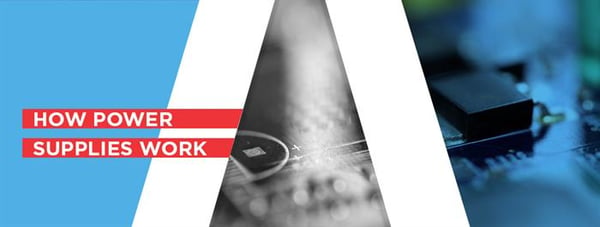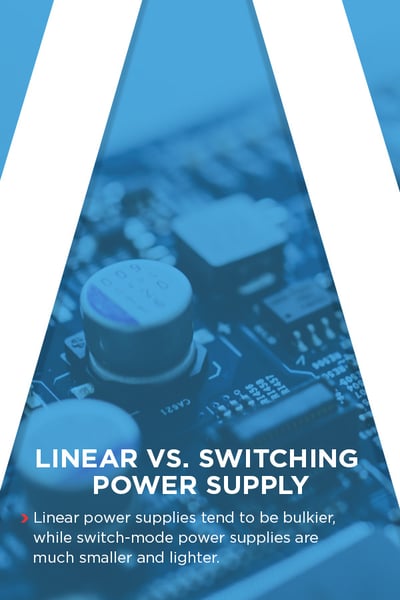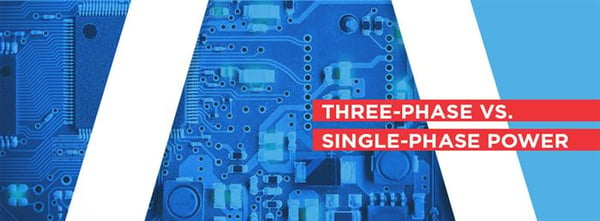RESOURCES
An Overview of Power Supplies for the Non-Engineer
Not all of us are engineers, but just about all of us do need power supplies. Power supplies provide and adapt power into the form we need for various tasks. In our modern world, power supplies are needed for so many things, but most people associate power supplies with their laptop or desktop computers. Without the right power supply, your computer would be nothing more than an oversized paperweight.
Our dependence on electrical power is evidenced in the fact that the world has consistently produced more energy every year with just one exception since 1974. Electrical energy is certainly useful, but it must be harnessed through a power supply. In this article, we're going to cover the power supplies basics you need to understand what a power supply is, how it works and what different types you'll find on the market today.
What is a Power Supply?
Even if you're not sure exactly what a power supply is, chances are that you rely on power supplies every day to carry about basic tasks like charging your cell phone, running your computer or playing music on a stereo. A power supply, also sometimes called a power supply unit, power supply module, power adapter or power brick, is the source that provides components with the type of electric power they need to run.
Typically, this task involves converting energy from one form into a more usable form for the component that's being powered. This may look like converting one type of electrical power, such as alternating current (AC), to another, such as direct current (DC). It could also look like converting a completely different form of energy, such as solar or mechanical, into electrical energy, though we aren't going to focus on this type of converter in this article.
Power supplies are often built right into the components they work for, so you may not even realize that, when you plug something into a socket in the wall, a power adapter is going to work converting the energy into the proper form. All forms of energy are not the same. To power up and function correctly, components need to use electrical energy that is a certain voltage, frequency and current.

How Power Supplies Work
Now that you understand what a power supply is, you may be wondering how this device works. The answer really depends on the type of power supply. As we'll see in the remainder of the article, there are many different basic types of power supplies and different features that dictate the way the power supply works. To understand the basics of how a power supply circuit works, let's talk about the basic components that make up a power supply. If you look at a power supply block diagram, these are the parts you'll likely see:
- Transformer: The transformer is made up of coils that are wrapped around a core. The transformer generates a magnetic field, thereby creating energy between the coils. The effect is that a transformer can increase or decrease an electrical current.
- Rectifier: A rectifier is an essential component in AC/DC power supplies. It only allows current to flow out of it in one direction, so when an alternating current enters, the rectifier converts it into a direct current. We'll talk more about the difference in alternating and direct currents below.
- Filter: Filters come in two basic types — capacitor inputs and choke inputs. In either case, a filter has an important task. The direct current from the rectifier will have some ripples in it. The filter's job is to smooth out these ripples. It also increases the average output voltage or current.
These components work together to deliver power to the component that needs power, also called a load. Power supplies don't just provide power — they provide it in the specific form a load needs to run properly.
Different Types of Power Supplies
If you're wondering what an AC power supply or a DC power supply is or have other questions pertaining to specific types of power supplies, we're going to answer them here. Now that we've taken some time to understand the basics of how power supplies work, let's take a moment to look at several different types of power supplies, what their applications are and how they work.
1. AC vs. DC Power
First, let's talk about the difference in alternating current (AC) and direct current (DC) power and what an AC/DC power converter is. The main difference between AC and DC has to do with the direction of the flow of electrons. In the case of AC power, the electrical current flows forwards and backward due to an oscillating voltage. This is why the current is called alternating. Charted out, it an AC current looks like a wave. DC power, on the other hand, flows forward in one direction at a non-oscillating constant voltage, so it looks like a straight line.
AC power is more efficient for transmitting electricity long distances, which is why most homes have AC power. When you plug something into your electrical outlet at home, you're tapping into AC power that has been converted to a lower voltage after being sent at a high voltage. AC power is just what you need for many everyday appliances, such as a lamp, for example. However, computers, cell phones, other electronics and any devices that run on a battery typically need DC power.
So, how does your computer, for example, get the DC power it needs? Devices like this use an AC/DC power adapter to convert the alternating current from the electrical outlet into the direct current the electronic needs to run. On most computer charging cords, the power adapter is often included in the middle and looks like a brick.
While the answer to the question of power conversion may seem simple, the process itself is fairly complex. We won't go into detail here on how an AC/DC power supply works, but it's helpful to know that AC/DC converters use inductors and capacitors to hold onto electrical currents and integrate them correctly. The end result is an alternating current that transforms into a direct current.

2. Linear vs. Switching Power Supply
Another distinction we can make when it comes to power supplies is linear vs. switching. Both types of power supplies provide DC power, but they go about converting AC power in different ways.
A linear power supply works by using a transformer to adjust the voltage of the AC power before it applies it to the regulator circuitry. A switching power supply, also called a switch mode power supply, does not use a transformer. Instead, it works by directly converting the AC line power into a DC voltage and then converts this raw DC voltage into a higher frequency AC signal. The regulator circuit then produces the appropriate voltage and current.
These two types of AC/DC power supplies don't just work differently — they also look different. Linear power supplies tend to be bulkier, while switch-mode power supplies are much smaller and lighter. This compactness makes switching power supplies best for portable equipment, but switching power supplies also have a disadvantage — they generate high-frequency noise that can cause a problem for sensitive analog circuitry. When you're powering sensitive electronics, linear power supplies tend to be better.
3. Regulated vs. Unregulated Power Supply
A couple of other terms you may hear are regulated linear power supply and unregulated linear power supply. A regulated power supply is designed to maintain a certain output voltage, independent from the current that the power converter taps into. In other words, you can count on a regulated power supply to deliver power at a consistent voltage. In some cases, a regulated power supply may have a few different regulators built in, so you can choose from a few voltage options.
An unregulated power supply, also called brute force power, does not have a regulator to keep the output voltage constant, so the output voltage directly reflects whatever the input voltage is. The fluctuations in an unregulated output voltage are, in effect, electrical noise. These fluctuations are sometimes called “ripple voltage." To help regulate an unregulated power supply, you can add a filter capacitor.
While it may seem like a regulated power supply is superior to unregulated, that isn't necessarily always the case. Unregulated power supplies can still work well as a power source as long as they are used to power the right loads. They cost less, which is why some people may choose them over regulated options. For powering sensitive electronics or other components that need a perfectly constant voltage, also called "clean" power, a regulated power supply is best.

4. Three-Phase vs. Single-Phase Power
How does a three-phase power supply work? What do phases mean in the context of power supply? Three-phase power is a type of AC power circuit that uses three wires, also called conductors. Each conductor carries an alternating current, and all this current is consistent in its frequency and voltage across all three conductors. However, at any given time, each conductor will be at a different point in the phase.
Remember that an AC current looks like a wave. A three-phase current, then, looks like three waves that rise and fall at different times. To be exact, the cycles of the conductors are all off from each other by one-third. So, at any given time, one conductor is reaching its peak, one is on its way down, and the other is on the way up. The result is a constant source of power, perfect for a balanced linear load. Three-phase power is best for industrial facilities that have high power demands since it provides significantly more power than a single-phase system.
Single-phase power is also a type of an AC power circuit, but it only uses two conductors. Typically, one of these two wires is the power wire, and the other one is a neutral wire. The electrical current flows from the power wire to the neutral wire. Single-phase power is the most common type of power people have in their homes. The standard system in the U.S. is a single-phase power system with one 120V power wire and one neutral wire. The resulting current is 120V.
Helpful Power Supply Features
So far, we've been focusing on contrasting types of power supplies. There are also some useful features that some power supplies offer. Here are a few helpful features you might see in some modern power supplies:
1. Uninterruptible
Uninterruptible power sounds like a good thing, and it is, but what is an uninterruptible power supply? An uninterruptible power supply (UPS) can detect when the primary power source loses power or when there is a power surge. The UPS is equipped with a battery that takes over for the normal supply when there's a power loss, and it keeps surges from damaging the component that's being powered. A UPS is especially helpful for powering equipment that would suffer greatly from an unexpected power disruption, such as a computer.
2. Programmable
As the name suggests, a programmable power supply is a linear power supply you can program remotely. This means you can use some sort of analog controller or digital interface to manipulate things like voltage and current. With AC power supplies, you can also program the frequency. This isn't a feature most common consumers who are just looking for a power supply for their PC need, but it can be useful in some cases.
3. High Efficiency
One thing you want to make sure you pay attention to when purchasing a power supply is its efficiency. Higher-efficiency power supplies waste less power. They also tend to be comprised of higher quality components and generate less heat. It's best to look for power supplies with an efficiency rating of 80 or higher. A high-efficiency rating like 92% means that almost all of the rated wattage is going to power your system, while only 8% is lost in the form of heat.
4. Liquid-Cooled
Since power supplies can get hot, engineers are always concerned with making sure they stay cool enough to run efficiently. Whereas most power supplies in the past have been cooled with air, newer supplies are sometimes available with liquid cooling. Liquid-cooled power supplies have some notable advantages. They can be smaller, they don't depend on specific ambient conditions, they don't heat up other components in an enclosure, they are usually environmentally sealed, and they're quiet.

Power Up with Astrodyne TDI
For more than 50 years, Astrodyne TDI has provided cutting-edge power solutions for a variety of contexts worldwide, including manufacturing, medical, military aerospace, general industry, consumer appliance and more. We manufacturer high-quality EMI filters and power supplies. Astrodyne TDI is the power supply leader and expert you can trust for all your power supply needs. Our power supplies come in a variety of configurations and range from as small as 5W all the way up to building blocks that can help power massive systems up to 500kW.
When you partner with Astrodyne TDI, you can power up with confidence, knowing you're working with the best equipment from a source you can trust to provide excellent customer service. We have manufacturing and design facilities in both China and the U.S., so we can ship most of our products within 24 hours. Contact us today to learn more about our products and how we can help provide the solutions you need.

